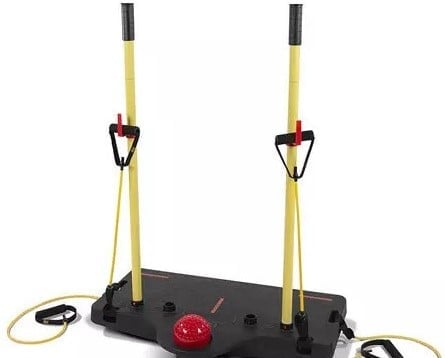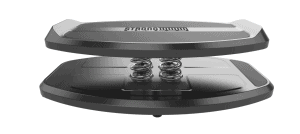
Image Credit: 60uP
Although older adults are at an increased risk of falling, ending up in the emergency room does not have to be inevitable as you age. While certain medical conditions and chronic issues can certainly increase risk factors associated with falling, adapting the right habits into your lifestyle can decrease your chances of falling. One unique way to combat falling? Using balance boards regularly. Here’s what you need to know about this intervention and the equipment you need to start.
Fall Prevention for Seniors
The Centers for Disease Control and Prevention reports that one in every four seniors fall yearly, making falls a public health concern among older adults. Most healthcare providers believe that the actual number of seniors falling at home is even higher than one out of every four, and that many seniors who fall at home and are not injured keep the incident to themselves. In any case, falling is a serious health concern for older adults.
Falls lead to emergency room visits and unplanned hospital stays, as well as inpatient therapy services in rehabilitation centers. For many seniors who have fallen, the incident negatively affects their physical health as well as their emotional well-being. Anxiety can escalate and seniors can find themselves avoiding certain favorite activities because they feel afraid of falling.
Fortunately, there is good news about falling when it comes to prevention. You can actively work on your balance, flexibility, mobility, strength, and endurance which can decrease your risk of falling and increase your chances of recovery if you do fall. And, if you are at risk for falls, it would be a good idea to have a medical alert device to get help fast. Our Medical Guardian review has all the information.
How Balance Boards Work

Balance boards come in a variety of shapes and sizes. Image credit: StrongBoard Balance
Balance boards come in a variety of styles, but share a similar feature. All balance boards are made up of some type of flat surface that sits on an unstable bottom. Balance boards are typically made up of wood or hard plastic, and are designed to work for people of all ages or abilities.
Balance boards create the right conditions for the user to actively work on stability and balance. Standing on the board requires concentration and small adjustments throughout the body in order to stay balanced. Over time, users will notice that balance becomes a bit easier, their posture is better, and they feel more stable while on the board and in daily life.
Benefits of Balance Boards
Balance boards are not new; physical therapists have been using balance boards as an intervention for patients for decades. However, now you are also likely to catch a glimpse of balance boards in your local gym or in your neighbor’s home. In fact, you can even find balance boards in the workplace, often used in tandem with stand-up desks.
Why is everyone jumping on the balance board bandwagon? Because the benefits are hard to top.
Balance boards engage the core and strengthen muscles that can often become weak due to a sedentary lifestyle. However, even active adults can see benefits from making balance boards part of their regular routine:
- Better posture thanks to stronger muscles in the back and neck
- Improved reaction time
- Increased balance and better response to unbalanced situations
- Improved motor skills as well as foot/ankle mobility
- Increased core strength and leg endurance
- Improved daily functional movement
Balance Boards for Seniors

Working with a physical therapist can help you build confidence so you can transition safely from seated balance work to standing.
One benefit of balance boards is that they can be used by almost anyone, from elite athletes to kids to seniors. Older adults can incorporate balance board work into their daily or weekly routine to actively work on their functional movement, mobility, flexibility, and steadiness.
Before starting your balance board journey, keep these tips in mind:
- Speak with your physician about your plans prior to starting.
- Work with a physical therapist as you get used to your board; you can also learn exercises or techniques to use at home.
- Don’t use a balance board if you have a recent history of falling.
- Wear sturdy shoes.
- Keep your balance board near a secure grab bar or surface so that you can safely get on and off.
- Don’t try your balance board when you are feeling tired.
- Wear your glasses or contacts while using the board.
- Take it slowly; you don’t have to perform squats or other exercises while on the balance board. Simply standing straight with good posture while on the board will give you the same benefits for your daily life.
- Beware of performing any balance exercises after taking certain medication that could alter your blood pressure or vision.
- Make sure you are wearing your medical alert device while using the balance board in case of emergency.
- Consider inviting a family member or friend over for your first few balance board sessions at home so that you feel safe and have help in case it is needed.
- Be open to sitting, instead of standing. Exercise balls offer the opportunity to work on balance while seated, giving you time to work up to standing balance board exercises.
Getting Started
Once you have your physician’s approval and physical therapist’s guidance, you can begin shopping for the balance board that is right for you. Fortunately, you have a lot of options to choose from so that you can find a board that suits your budget, lifestyle, and home.
Here are questions to ask yourself as you find the balance board best for you.
- What is my budget? Boards range from $20-$250, based on their purpose and design.
- Where do I want to put it? If you need a board that you can tuck under a desk or bed so that it doesn’t cause you to walk out of your way to get around your home, look for one designed to do so. If you have a gym space and don’t mind the board staying out, you can find a larger one without worrying about tucking it away.
- Do I need built-in handles for added support? The 60uP balance board system is great for seniors with its handles for added stability and safety.
- Do I want to connect it to my Wii video game system? Many older adults purchased a Wii gaming system to take advantage of the active games like bowling or tennis. If you have a Wii system, or can find one at a resale shop, you can purchase a Wii balance board attachment to use with certain games.
- How much do I weigh? While most balance boards support a reasonable amount of weight, you should especially consider the maximum weight recommendation if you are planning on adding weights while working out on the board.
- Is there enough room for me to stand comfortably? Balance boards work best for seniors if they offer enough room for the senior to stand comfortably. If you have a naturally wider standing posture, find a board that can accommodate that.
Balance boards can greatly improve posture, balance, mobility, and strength for older adults. Talk to your physician if balance board work would be a good addition to your daily or weekly routine.


